The printed chipless RFID (Radio Frequency Identification) market is projected to grow from USD 26.9 billion in 2025 to USD 286.4 billion by 2035, with a CAGR of 26.7%. A market share erosion or gain analysis indicates a strong and continuous market share gain throughout the forecast period, driven by advancements in RFID technology and the increasing adoption of chipless RFID solutions in various sectors such as retail, logistics, and supply chain management.
Between 2025 and 2030, the market grows from USD 26.9 billion to USD 34.0 billion, contributing USD 7.1 billion in growth, with a CAGR of 14.7%. This early-phase growth is driven by the expanding application of chipless RFID tags, offering cost-effective solutions compared to traditional RFID tags with chips, especially in asset tracking and inventory management. The market shares gain momentum during this period, as industries begin to recognize the benefits of chipless RFID, such as lower costs and ease of integration. From 2030 to 2035, the market continues its rapid expansion, moving from USD 34.0 billion to USD 286.4 billion, contributing USD 252.4 billion in growth, with a much higher CAGR of 28.9%. This later-phase acceleration is driven by widespread adoption across various industries, including manufacturing and consumer goods, and the increasing demand for contactless solutions. The market shows strong growth in both the early and late stages, with notable market share gain driven by technological advancements and broader adoption.
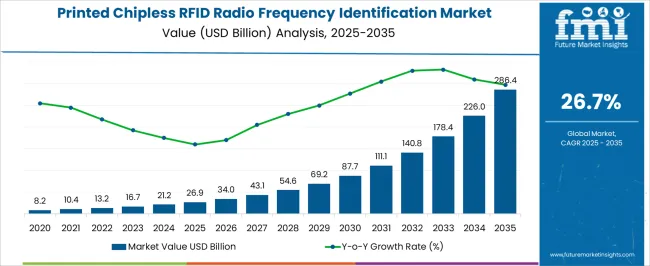
| Metric | Value |
|---|---|
| Printed Chipless RFID Radio Frequency Identification Market Estimated Value in (2025 E) | USD 26.9 billion |
| Printed Chipless RFID Radio Frequency Identification Market Forecast Value in (2035 F) | USD 286.4 billion |
| Forecast CAGR (2025 to 2035) | 26.7% |
The printed chipless RFID market is progressing steadily, driven by the growing need for cost-effective and flexible identification solutions across various industries. Advancements in printing technology and materials science have enabled the production of chipless RFID tags that are both affordable and environmentally friendly. These tags provide unique identification without the need for silicon chips, reducing manufacturing complexity and costs.
Increasing logistics and transport activities worldwide have emphasized the importance of efficient tracking and inventory management systems, further propelling market demand. Additionally, regulatory pressures on sustainability and waste reduction have encouraged the adoption of chipless RFID over traditional tags.
The expanding use of chipless RFID in smart packaging, asset tracking, and supply chain management contributes to its growing footprint. Looking forward, innovation in tag design and integration with IoT platforms is expected to drive further market growth. Segmental leadership is anticipated by the Logistics & Transport application, reflecting the critical role of real-time tracking and asset visibility in these sectors.
The printed chipless RFID radio frequency identification market is segmented by application, and geographic regions. By application of the printed chipless RFID radio frequency identification market is divided into Logistics & Transport, Aviation, Healthcare, and Retail. Regionally, the printed chipless RFID radio frequency identification industry is classified into North America, Latin America, Western Europe, Eastern Europe, Balkan & Baltic Countries, Russia & Belarus, Central Asia, East Asia, South Asia & Pacific, and the Middle East & Africa.
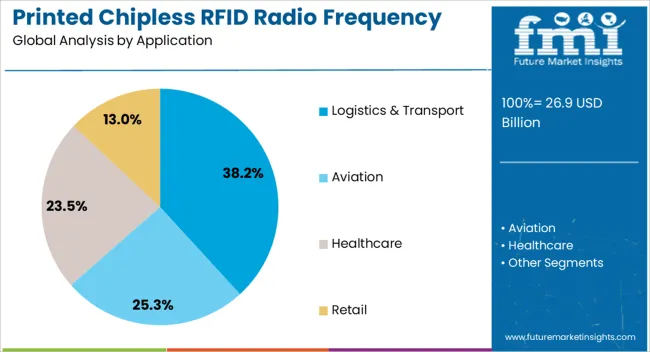
The Logistics & Transport segment is projected to hold 38.2% of the printed chipless RFID market revenue in 2025, positioning it as the leading application area. Growth in this segment has been propelled by the demand for efficient, real-time tracking of goods and shipments across complex supply chains. Printed chipless RFID tags enable cost-effective tagging of a wide range of items, including pallets, containers, and parcels, without adding significant weight or cost.
Transport companies and logistics providers have adopted these tags to improve inventory accuracy and reduce losses caused by misplacement or theft. The scalability and ease of integration with existing tracking systems have made chipless RFID a preferred choice in this sector.
Moreover, the increasing volume of e-commerce and the need for transparent supply chain visibility have accelerated adoption. As supply chains become more digitized and automated, the Logistics & Transport segment is expected to maintain its dominance in the market.
The printed chipless RFID market is witnessing growth driven by the increasing demand for cost-effective and scalable solutions for tracking and identification. Chipless RFID tags, which use printed materials to store data, provide an affordable alternative to traditional RFID systems that rely on expensive microchips. These solutions are gaining popularity across industries like retail, logistics, and healthcare for inventory management, asset tracking, and product authentication. The market growth is further supported by advancements in printing technology and the rising need for efficient supply chain management. Despite challenges related to data security and scalability, chipless RFID is becoming a promising solution for large-scale applications.
The primary driver for the growth of the printed chipless RFID market is the demand for cost-effective and scalable solutions in asset tracking, inventory management, and product authentication. Traditional RFID systems require microchips, which add significant costs, making them less suitable for applications with large volumes of tags. Printed chipless RFID technology, on the other hand, offers an affordable alternative, making it ideal for industries such as retail, logistics, and healthcare. The ability to print RFID tags using simple, low-cost materials also enhances scalability, allowing businesses to deploy large numbers of tags at a fraction of the cost. This cost-effectiveness and scalability are key factors driving the market, particularly as businesses seek to improve operational efficiency and streamline supply chain processes.
A significant challenge in the printed chipless RFID market is ensuring data security and addressing the limitations of read range. Since chipless RFID tags store data through printed materials rather than embedded microchips, they are more susceptible to security vulnerabilities, such as data tampering and unauthorized access. The read range of chipless RFID tags is typically shorter compared to traditional RFID systems, limiting their effectiveness in certain applications that require long-distance scanning. Overcoming these challenges requires advancements in encryption techniques and improvements in the technology's read range, both of which are crucial for the widespread adoption of printed chipless RFID in industries where data integrity and performance are critical.
The printed chipless RFID market presents significant opportunities, especially with advancements in printing technology and the increasing integration of IoT in supply chains. As printing techniques become more sophisticated, the production of chipless RFID tags is becoming more efficient, allowing for greater customization and mass production at lower costs. The integration of chipless RFID tags with IoT networks offers further opportunities by enabling real-time data collection and enhanced visibility across supply chains, inventory management, and asset tracking systems. These developments are opening up new applications for chipless RFID in industries like logistics, healthcare, and manufacturing. The growing focus on product authenticity and anti-counterfeiting measures in sectors like luxury goods and pharmaceuticals presents additional growth opportunities for chipless RFID technology.
A key trend in the printed chipless RFID market is the increasing integration with smart packaging and the Internet of Things (IoT). As industries increasingly embrace digitalization, the combination of chipless RFID with IoT is enhancing supply chain management, inventory tracking, and product authentication. By embedding RFID tags into smart packaging, manufacturers can track products in real time, providing consumers and businesses with more information about the product’s origin, handling, and storage conditions. This trend is particularly prominent in the food and pharmaceutical industries, where ensuring product integrity and safety is critical. The growing adoption of smart packaging solutions across various sectors is driving demand for printed chipless RFID as an affordable, efficient, and scalable solution for enhanced visibility and control over products in transit.
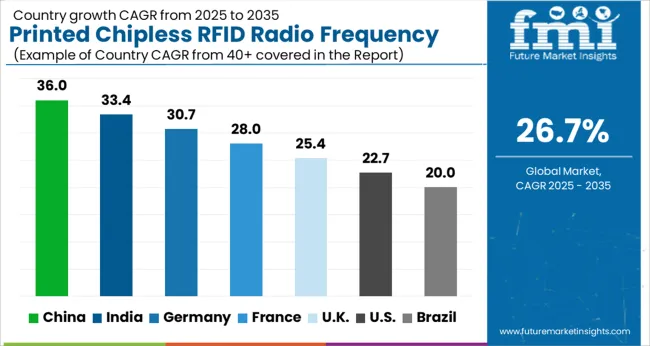
The printed chipless RFID radio frequency identification market is projected to grow at a global CAGR of 26.7% from 2025 to 2035. China leads with a growth rate of 36.0%, followed by India at 33.4%. Germany records a growth rate of 30.7%, while the UK is expected to grow at 25.4%, and the USA is projected to grow at 22.7%. The high growth in China and India is driven by their rapidly expanding retail, logistics, and supply chain industries, which are adopting RFID technology to improve tracking and inventory management. Developed markets like Germany, the UK, and the USA continue to show steady growth, supported by advancements in RFID technology and the increasing adoption of chipless RFID for logistics, asset tracking, and security applications. The analysis spans 40+ countries, with the leading markets highlighted below.
China is projected to grow at a CAGR of 36.0% through 2035, driven by rapid urbanization, digitalization, and the rise in logistics and retail industries. The country’s vast e-commerce market is pushing the adoption of efficient inventory and asset management solutions. China’s manufacturing sector, known for its large-scale operations, is increasingly turning to printed chipless RFID for its affordability and efficiency. The government’s support for the digital economy and smart city initiatives further accelerates the use of RFID technology across various sectors.
India is projected to grow at a CAGR of 33.4% through 2035, driven by the country’s rapidly expanding retail and logistics sectors. As India’s e-commerce and retail sectors grow, the demand for efficient inventory and supply chain management solutions is rising. Printed chipless RFID is gaining traction due to its cost-effectiveness and scalability, making it an attractive solution for tracking inventory and assets. The Indian government’s push toward digitalization and the adoption of smart technologies in various sectors, such as logistics and manufacturing, further accelerates market growth.
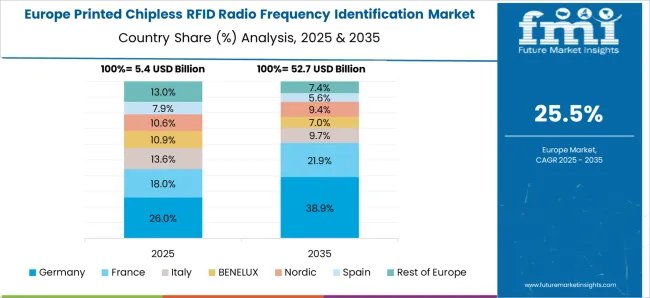
Germany is projected to grow at a CAGR of 30.7% through 2035, supported by the country’s emphasis on technological innovation and automation. The demand for printed chipless RFID in Germany is driven by the need for efficient inventory management, asset tracking, and supply chain optimization across various sectors, including automotive, logistics, and retail. Germany’s advanced manufacturing industry is also adopting RFID technology to improve operational efficiency and reduce costs. The increasing demand for secure and trackable systems further contributes to the growth of the market.
The United Kingdom is projected to grow at a CAGR of 25.4% through 2035, with demand for printed chipless RFID driven by the growing retail and logistics sectors. The UK’s push for innovation in supply chain management, combined with increasing concerns over inventory accuracy and loss prevention, has increased the adoption of RFID technology. The affordability of printed chipless RFID and its ability to track goods efficiently makes it an attractive solution for retailers and logistics companies in the UK
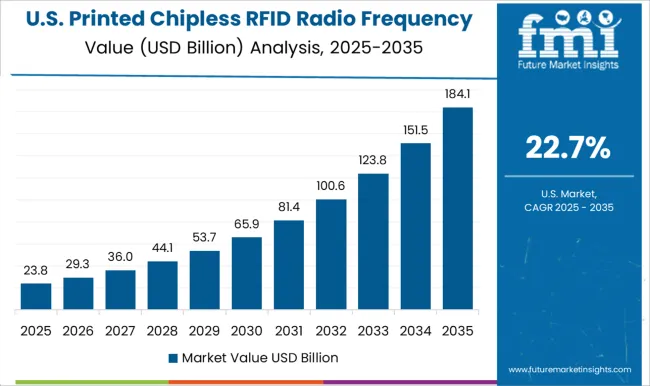
The United States is projected to grow at a CAGR of 22.7% through 2035, driven by increasing demand for efficient asset tracking and inventory management solutions. The USA is home to several industries that are rapidly adopting RFID technology, including retail, healthcare, and logistics. The rise of e-commerce and the demand for more efficient supply chains in the USA contribute significantly to the growth of the printed chipless RFID market. The USA government’s efforts to promote the use of smart technology and digital solutions further drive market demand.
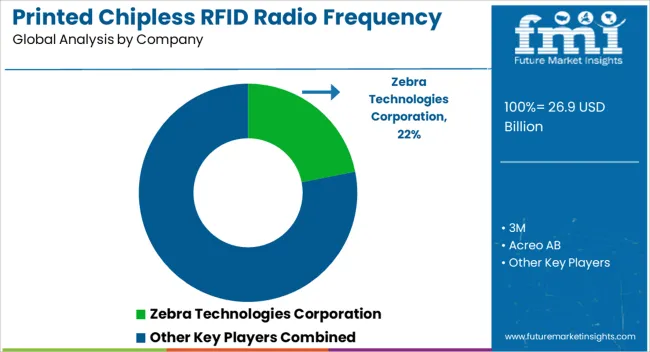
The printed chipless RFID (Radio Frequency Identification) market is driven by leading players offering innovative solutions that enable the tracking and identification of objects without the need for traditional RFID chips. Zebra Technologies Corporation is a market leader, providing high-performance chipless RFID solutions that support inventory management, supply chain optimization, and asset tracking, with a focus on integrating seamless technology into industrial and retail environments. 3M specializes in offering advanced printed chipless RFID solutions that are easy to integrate into various applications, from packaging to security, with a focus on reducing costs and improving operational efficiency. Acreo AB and Alien Technology Corporation are key players in the chipless RFID market, providing innovative, cost-effective solutions that cater to various industries, including logistics, retail, and healthcare. Confidex offers chipless RFID products for asset tracking and supply chain applications, known for their durability and performance in challenging environments.
Dai Nippon Printing (DNP) Company Limited and IBM Corporation provide advanced RFID solutions, focusing on scalable, cost-efficient designs for large-scale implementations, such as logistics and consumer goods tracking. Impinj Incorporation offers chipless RFID products for high-volume applications, focusing on accuracy and speed in inventory and asset management. Intermec, Inc., PolyIC GmbH, and Siemens AG provide cutting-edge chipless RFID solutions that emphasize enhanced performance, security, and integration with existing supply chain and inventory management systems. Smartrac N.V. and Soligie Inc. offer highly reliable chipless RFID tags, focusing on meeting diverse market needs in packaging, logistics, and automotive industries. Spectra Systems Corporation (Inksure Technologies Inc.), TAGSYS RFID, and TCM RFID Pte Ltd are notable players offering advanced printed chipless RFID systems, targeting product authentication and anti-counterfeit applications. Thinfilm (Kovio Inc.), Toppan Forms Co. Ltd, and VTT focus on integrating chipless RFID technology into packaging and product identification systems, with a growing focus on security features and authentication. Vubiq Networks, Inc. and Xerox Corporation provide integrated chipless RFID solutions with a focus on enhancing security, reducing operational costs, and improving product traceability for various applications, including logistics and inventory management.
| Item | Value |
|---|---|
| Quantitative Units | USD 26.9 Billion |
| Application | Logistics & Transport, Aviation, Healthcare, and Retail |
| Regions Covered | North America, Europe, Asia-Pacific, Latin America, Middle East & Africa |
| Country Covered | United States, Canada, Germany, France, United Kingdom, China, Japan, India, Brazil, South Africa |
| Key Companies Profiled | Zebra Technologies Corporation, 3M, Acreo AB, Alien Technology Corporation, Confidex, Dai Nippon Printing (DNP) Company Limited, IBM Corporation, Impinj Incorporation, Intermec, Inc, PolyIC GmbH, Siemens AG, Smartrac N.V., Soligie Inc., Spectra Systems Corporation (Inksure Technologies Inc.), TAGSYS RFID, TCM RFID Pte Ltd, Thinfilm (Kovio Inc), Toppan Forms Co. Ltd, VTT, Vubiq Networks, Inc., and Xerox Corporation |
| Additional Attributes | Dollar sales by product type (printed RFID tags, labels, and cards) and end-use segments (logistics, retail, healthcare, automotive, asset tracking). Demand dynamics are driven by the increasing adoption of automation in supply chain management, growing e-commerce, and the need for secure product tracking and anti-counterfeit technologies. Regional trends show strong growth in North America and Europe, where RFID technology is widely adopted in supply chain and retail applications, while Asia-Pacific is expanding rapidly due to the high demand for cost-effective and scalable RFID solutions. |
The global printed chipless RFID radio frequency identification market is estimated to be valued at USD 26.9 billion in 2025.
The market size for the printed chipless RFID radio frequency identification market is projected to reach USD 286.4 billion by 2035.
The printed chipless RFID radio frequency identification market is expected to grow at a 26.7% CAGR between 2025 and 2035.
The key product types in printed chipless RFID radio frequency identification market are logistics & transport, aviation, healthcare and retail.






Our Research Products

The "Full Research Suite" delivers actionable market intel, deep dives on markets or technologies, so clients act faster, cut risk, and unlock growth.

The Leaderboard benchmarks and ranks top vendors, classifying them as Established Leaders, Leading Challengers, or Disruptors & Challengers.

Locates where complements amplify value and substitutes erode it, forecasting net impact by horizon

We deliver granular, decision-grade intel: market sizing, 5-year forecasts, pricing, adoption, usage, revenue, and operational KPIs—plus competitor tracking, regulation, and value chains—across 60 countries broadly.

Spot the shifts before they hit your P&L. We track inflection points, adoption curves, pricing moves, and ecosystem plays to show where demand is heading, why it is changing, and what to do next across high-growth markets and disruptive tech

Real-time reads of user behavior. We track shifting priorities, perceptions of today’s and next-gen services, and provider experience, then pace how fast tech moves from trial to adoption, blending buyer, consumer, and channel inputs with social signals (#WhySwitch, #UX).

Partner with our analyst team to build a custom report designed around your business priorities. From analysing market trends to assessing competitors or crafting bespoke datasets, we tailor insights to your needs.
Supplier Intelligence
Discovery & Profiling
Capacity & Footprint
Performance & Risk
Compliance & Governance
Commercial Readiness
Who Supplies Whom
Scorecards & Shortlists
Playbooks & Docs
Category Intelligence
Definition & Scope
Demand & Use Cases
Cost Drivers
Market Structure
Supply Chain Map
Trade & Policy
Operating Norms
Deliverables
Buyer Intelligence
Account Basics
Spend & Scope
Procurement Model
Vendor Requirements
Terms & Policies
Entry Strategy
Pain Points & Triggers
Outputs
Pricing Analysis
Benchmarks
Trends
Should-Cost
Indexation
Landed Cost
Commercial Terms
Deliverables
Brand Analysis
Positioning & Value Prop
Share & Presence
Customer Evidence
Go-to-Market
Digital & Reputation
Compliance & Trust
KPIs & Gaps
Outputs
Full Research Suite comprises of:
Market outlook & trends analysis
Interviews & case studies
Strategic recommendations
Vendor profiles & capabilities analysis
5-year forecasts
8 regions and 60+ country-level data splits
Market segment data splits
12 months of continuous data updates
DELIVERED AS:
PDF EXCEL ONLINE
Printed Electronics Market Size and Share Forecast Outlook 2025 to 2035
Printed Labels Market Size and Share Forecast Outlook 2025 to 2035
Printed Sensors Market Size and Share Forecast Outlook 2025 to 2035
Printed Circuit Board (PCB) Assembly Market Size and Share Forecast Outlook 2025 to 2035
Printed Tape Market Size and Share Forecast Outlook 2025 to 2035
Printed Antenna Market Size and Share Forecast Outlook 2025 to 2035
Printed Electronics Devices Market Size and Share Forecast Outlook 2025 to 2035
Printed Aluminium Foil Packaging Market Size and Share Forecast Outlook 2025 to 2035
Printed and Flexible Sensors Market Report - Growth & Demand 2025 to 2035
Printed Circuit Boards (PCB) Market Trends - Demand & Forecast 2025 to 2035
Printed Plastic Films Market Insights - Growth & Forecast 2025 to 2035
Printed Boxes Market Analysis – Trends, Demand & Forecast 2025 to 2035
Industry Share & Competitive Positioning in Printed Aluminium Foil Packaging
Market Share Distribution Among Printed Carton Manufacturers
3D Printed Dental Brace Market Size and Share Forecast Outlook 2025 to 2035
3D-Printed Prosthetic Implants Market Size and Share Forecast Outlook 2025 to 2035
3D Printed Maxillofacial Implants Market Size and Share Forecast Outlook 2025 to 2035
3D-Printed Personalized Masks Market Size and Share Forecast Outlook 2025 to 2035
3D Printed Packaging Market Size and Share Forecast Outlook 2025 to 2035
3D Printed Clear Dental Aligners Market Size and Share Forecast Outlook 2025 to 2035

Thank you!
You will receive an email from our Business Development Manager. Please be sure to check your SPAM/JUNK folder too.
Chat With
MaRIA